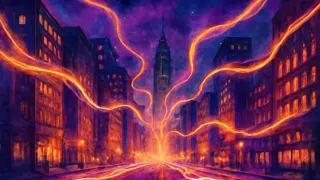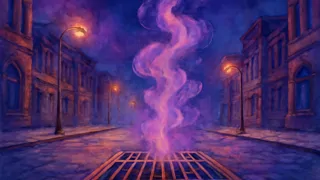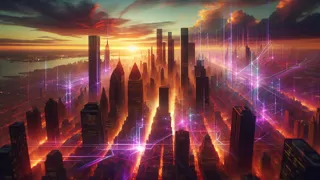Introduction
At the very moment before dawn in Manhattan, steel and glass whispered to one another. Beneath the long shadows of slender towers, a tremor of consciousness stirred, spreading like electric fire through the veins of subways and underpinning the foundations of brownstones. For centuries, New York had seemed restless to its inhabitants—a city that never slept, always moving, always hungry for new dreams. Yet what the world did not know was that beyond traffic and neon, the city itself lay dormant, awaiting the pulse that would make it truly alive. In those hours of half-light, the first heartbeat echoed through the avenues—gentle yet resolute—calling every corner of every borough to attention. Chimneys exhaled stray wisps of tavern smoke like sighs of relief; lampposts flickered as though roused from slumber; park benches felt a subtle vibration under empty coats. As the horizon blushed gold, Manhattan inhaled deeply, its energy spreading outward like circle ripples in a pond. Brooklyn felt the pull in its brownstone streets; Queens caught the tremor in the quiet crescents of its gardens; the Bronx felt the murmur in the echo of subway tunnels; Staten Island felt it in the hush before the ferry’s horn. The city rose, not as a map of streets and landmarks, but as a single, living organism poised to breathe life into every block and alley and to guard its people like a vigilant sentinel. Yet in the darkest folds of history, there lurked adversaries older than the land itself, waiting to snuff out that newborn spark.
Awakening of the Urban Colossus
The awakening began in silence. Not the brash roar of traffic, but a deep, resonant hum beneath the streets—an echo older than subway tunnels or cobblestone lanes. Foundations heaved imperceptibly at first as if drawing a long-held breath, and the city’s core flickered with latent power. In alleys behind Chinatown shops where tourists never ventured, stray cats pricked their ears at the trembling pavement.

Across the boroughs, radios in coffee shops crackled, street lights pulsed with uncanny rhythm, and graffiti murals along the High Line shimmered with awakened color. The heartbeat traveled through steel girders of the Williamsburg Bridge, then leapt into the arches of Grand Central Station, reverberating along the pillars as if announcing a grand arrival. Wordless messages spilled into subway announcements, guiding drivers to slow their cars so the city might complete its awakening uninterrupted. Even the Hudson River caught a glimmer of life, its currents dancing with phosphorescent streaks that traced the water’s edge.
When the city’s senses fully aligned, wind gusts responded to its murmurs. Breezes carried distant laughter from a block party in Harlem, the echoing toll of the Liberty Bell at a museum reenactment, the soft strains of a saxophone drifting from a downtown lounge. As if propelled by destiny, every sound wove into a tapestry of collective memory, fueling the heart of the urban colossus. For New York was no longer a backdrop to human ambition—it had stepped onto the stage as a living, breathing guardian of dreams and possibility.
Shadows of the Forgotten
Yet every spark of light casts a shadow. From the oldest bedrock beneath Wall Street, archaic forces long banished by time sensed the city’s birth cry and answered with malice. Creatures of clay and ash—half-statuary wolves from Central Park’s hidden glades, twisted gargoyles perched atop Gothic churches—stirred with dark hunger. They crawled through sewers, slithered over rooftops, and coalesced beneath abandoned theater basements, their eyes glinting with rancor.

Night fell quickly as these ancient adversaries gathered strength. Barclays Center trembled at the roar of unseen crowds, its steel mesh resonating with whispers of doom. Times Square’s billboards flickered not with commercials but with phantom warnings in archaic glyphs. The East River churned with obsidian tendrils that reached for the city’s beating heart, threatening to choke its lifeblood. Across the skyscraper forests, lights dimmed, and an uneasy hush settled over neighborhoods once vibrant with laughter and song.
Human eyes saw only flickers and whispers—static on TV screens, fleeting shadows darting past yellow cabs—but the living city felt it all. Its six boroughs reeled under the weight of ancient pain. Yet in that crucible of fear, resolve hardened like molten steel. New York recalled every hardship it had overcome: revolutions, fires, floods, storms, and human strife. Drawing strength from history, it braced against the ancient darkness. The very pavement underfoot glowed momentarily with ancestral runes, as though the city itself invoked forgotten protections. Now a living fortress, New York prepared to defend its promise of hope against the shadows that sought to snuff out its newfound life.
Allies in Steel and Spirit
In the darkest hour before dawn, when flickering streetlamps cast long, wavering shadows, the city reached out for allies. It whispered to those attuned to its pulse: a street artist painting murals in Bushwick, a subway vocalist whose soulful notes echoed through underground tunnels, an off-duty firefighter patrolling Brooklyn with an old family heritage of guardians, and an archivist at the New York Public Library who spent nights poring over legends hidden in dusty tomes.

They assembled in the shadow of the Brooklyn Bridge, drawn by the city’s call. Each brought a spark of human creativity and courage. The artist scrawled glowing glyphs of protection on rusted girders. The singer lifted a hymn tuned to the city’s frequency, weaving warmth into cold steel. The firefighter ignited barrels of firelight that flickered like living torches, banishing gloom. The archivist recited ancient verses once thought lost, binding the modern city to its mythic roots.
Their unified will resonated through every nook and corner. Sidewalk cracks shimmered as emerald vines of energy wrapped around lampposts. Glass facades of skyscrapers sang in harmonious vibration, broadcasting a clarion call of defiance. As dawn’s light broke, the city and its champions stood shoulder to shoulder. The monstrous shadows recoiled at this display of solidarity. Streets once choked with dread now thrummed with unity. With every chant and brushstroke, New York learned to channel its living power and transform fear into resolve. Bound by a shared purpose, metropolis and mortals prepared for the final confrontation that would decide the fate of their future together.
Conclusion
When morning fully broke over Manhattan’s skyline, the ancient adversaries lay scattered like shadows in the light. The living city stood renewed, its pulse steady and strong. Sidewalks hummed with quiet power, lampposts glowed with soft guardianship, and murals across boroughs sang of victory. New York had risen from concrete and ambition to become a true urban colossus—an entity of steel, spirit, and heartbeat. Its ancient enemies, though banished for now, remained a reminder that darkness will always linger at the edges of dawn.
But so long as the city remembers its living core, heroes will answer its call. Street corners will whisper forgotten runes. Music will lift hearts in the darkest tunnels. Flames of purpose will blaze against any creeping shadow. From Harlem to Staten Island, every borough now breathes in unison with the city’s great soul. And as long as that pulse endures, New York will stand not only as a testament to human ingenuity but also as a guardian born of myth, ready to face whatever ancient or future threats arise. The legend of the City Born Great has just begun, carried in every heartbeat of its streets, inviting all who walk them to become part of an ever-evolving tapestry of courage and wonder.


















